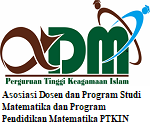Student Group Dynamic Model Based on Understanding in Mathematics Subjects
DOI:
https://doi.org/10.15642/mantik.2021.7.1.41-50Keywords:
Dynamical system, Mathematical model, Equilibrium points, Student interaction, Learning processAbstract
This study discusses the interaction of students with a mathematical modeling point of view. This interaction involves students who understand and do not understand mathematics subject matter. The interaction process between groups is modeled in a two-dimensional system of differential equations. Variable A is the percentage of students who understand the material, and variable B is the percentage of students who do not understand the material. The dynamic analysis results obtained by one trivial equilibrium point and three non-trivial equilibrium points exist with several conditions. Based on the stability analysis of the non-trivial equilibrium point, it is found that the conditions without students do not understand mathematics subject matter. This condition is the goal of this study, which involves interaction between students; it can increase the learning process's success.
Downloads
References
E. Humrey, Encyclopedia Internasional. New York: Grolier, 1975.
E. Bruce-Jones, “Beiter, ‘The Protection of the Right to Education by International Law,’” MenschenRechtsMagazin, vol. 3. Universitätsverlag Potsdam, pp. 325–326, 2006.
Sekretariat Negara RI, Undang-Undang Republik Indonesia No.20 Tahun 2003 Tentang Sistem Pendidikan Nasional. 2003, p. 2.
Sekretariat Negara RI, Undang-Undang Republik Indonesia No.14 Tahun 2005 Tentang Guru dan Dosen. 2005.
M. Yusuf, Pengantar Ilmu Pendidikan, 1st ed. Palopo: Lembaga Penerbit Kampus IAIN Palopo, 2018.
A. C. Sari, “Meningkatkan Kemampuan Pemecahan Masalah Matematis Siswa SMP dengan Model Pembelajaran Think Talk Write,” J. Math. Educ. Sci., vol. 1, no. April, pp. 7–13, 2018.
N. K. Roestiyah, Masalah Pengajaran Sebagai Suatu Sistem. Rineka Cipta, 1994.
D. Kuhn, V. Shaw, and M. Felton, “Effects of dyadic interaction on argumentive reasoning,” Cogn. Instr., vol. 15, no. 3, pp. 287–315, 1997.
D. P. Martin and S. E. Rimm-Kaufman, “Do student self-efficacy and teacher-student interaction quality contribute to emotional and social engagement in fifth grade math?,” J. Sch. Psychol., vol. 53, no. 5, pp. 359–373, Oct. 2015, doi: 10.1016/j.jsp.2015.07.001.
R. Leikin and O. Zaslavsky, “Facilitating student interactions in mathematics in a cooperative learning setting,” J. Res. Math. Educ., vol. 28, no. 3, pp. 331–354, 1997, doi: 10.2307/749784.
V. Murdock-Stewart, Making sense of students’ understanding of fractions: An exploratory study of sixth graders’ construction of fraction concepts through the use of physical referents and real world representations. The Florida State University, 2005.
J. Piaget and E. Duckworth, “Genetic Epistemology,” Am. Behav. Sci., vol. 13, no. 3, pp. 459–480, Jan. 1970, doi: 10.1177/000276427001300320.
I. Ismanto and M. I. A. Fathoni, “Strategi Pencegahan Endemi HIV/AIDS dengan Menggunakan Pemodelan Matematika,” MAJAMATH J. Mat. dan Pendidik. Mat., vol. 2, no. 1, pp. 32–41, 2019.
M. Uliyandari, I. N. Candra, and S. Sumpono, “Analisis Tingkat Pemahaman Siswa Kelas XII IPA SMA Negeri Kota Bengkulu untuk Mata Pelajaran Kimia,” 2014.
L. E. Febriyanti, M. Martosudiro, and T. Hadiastono, “Pengaruh Plant Growth Promoting Rhizobacteria (PGPR) terhadap Infeksi Peanut Stripe Virus (PStV), Pertumbuhan dan Produksi Tanaman Kacang Tanah (Arachis hypogaea L.) Varietas Gajah,” J. Hama dan Penyakit Tumbuh., vol. 3, no. 1, p. pp-84, 2015.
D. S. N. Afifah, “Interaksi belajar matematika siswa dalam pembelajaran kooperatif tipe STAD,” Pedagog. J. Pendidik., vol. 1, no. 2, pp. 145–152, 2012.
C. Febriyanti and S. Seruni, “Peran minat dan interaksi siswa dengan guru dalam meningkatkan hasil belajar matematika,” Form. J. Ilm. Pendidik. MIPA, vol. 4, no. 3, 2015.
M. I. A. Fathoni, Gunardi, F. A. Kusumo, and S. H. Hutajulu, “Mathematical model analysis of breast cancer stages with side effects on heart in chemotherapy patients,” in AIP Conference Proceedings, 2019, vol. 2192, doi: 10.1063/1.5139153.
W. E. Boyce, R. C. DiPrima, and D. B. Meade, Elementary differential equations. John Wiley & Sons, 2017.
Y. W. Putranto, “Analisis Titik Ekuilibrium dan Solusi Model Interaksi Pemangsa-Mangsa Menggunakan Metode Dekomposisi Adomian,” Universitas Sanata Dharma, 2017.
W. Ningsih and R. Khusniah, “Analisis Dinamis Model Matematika Pertumbuhan Jumlah Mahasiswa Program Studi Pendidikan Matematika STKIP PGRI Pasuruan,” J. Math. Educ. Sci., vol. 1, no. October, pp. 61–66, 2018.
Downloads
Published
How to Cite
Issue
Section
License
- Authors retain copyright and grant the journal right of first publication with the work simultaneously licensed under a Creative Commons License that allows others to share the work with an acknowledgment of the work's authorship and initial publication in this journal.
- Authors are able to enter into separate, additional contractual arrangements for the non-exclusive distribution of the journal's published version of the work (e.g., post it to an institutional repository or publish it in a book), with an acknowledgment of its initial publication in this journal.
- Authors are permitted and encouraged to post their work online (e.g., in institutional repositories or on their website) prior to and during the submission process, as it can lead to productive exchanges, as well as earlier and greater citation of published work







.png)




